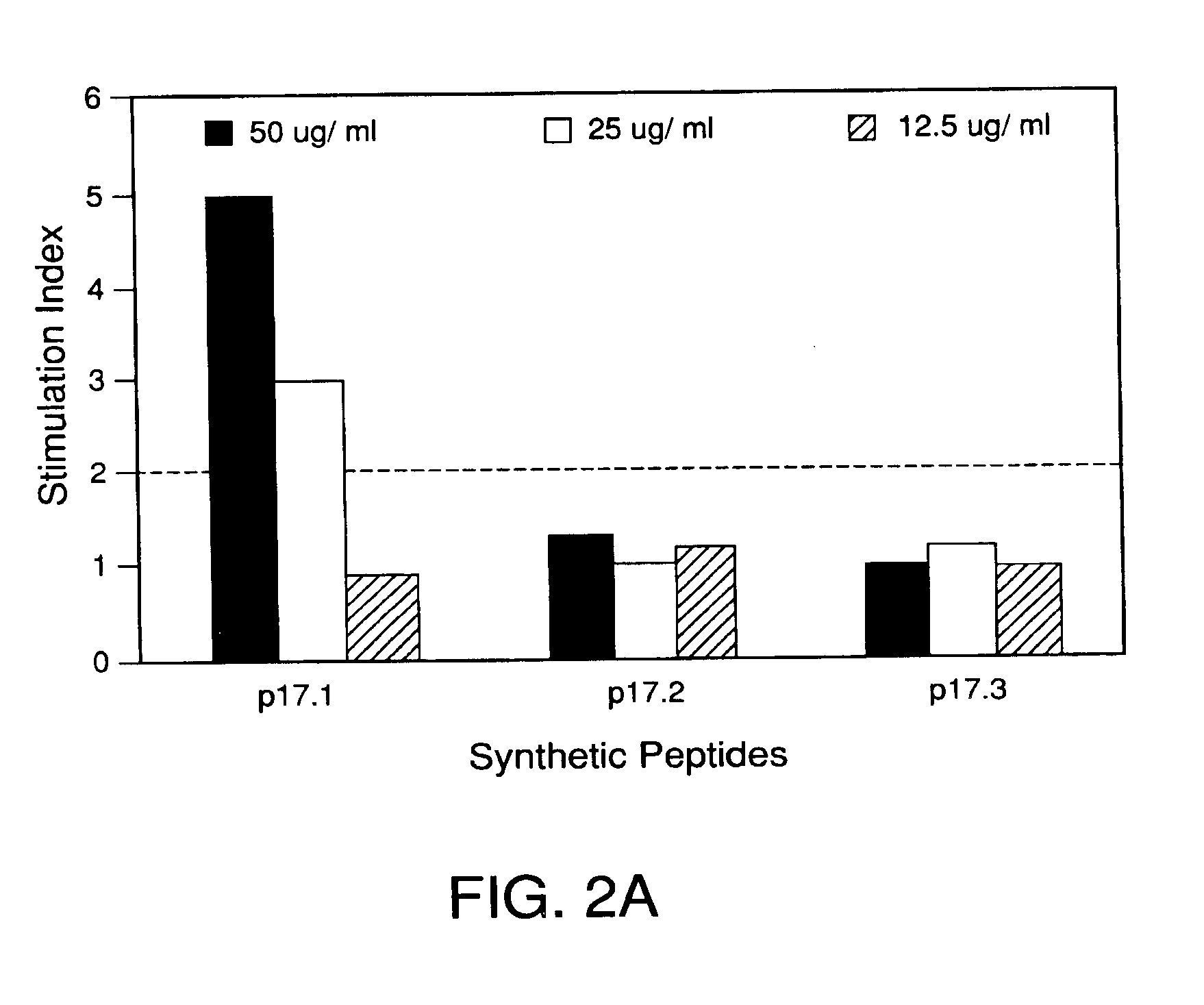Immunoreactive peptides from Epstein-Barr virus
- Summary
- Abstract
- Description
- Claims
- Application Information
AI Technical Summary
Problems solved by technology
Method used
Image
Examples
example1
SYNTHESIS OF p17 AND p50 POLYPEPTIDES
[0084]Potential T cell epitopes on the p17 protein were identified using Berzofsky's algorithm (AMPHI Program) (1987). This algorithm postulates that T-cells preferentially interact with peptides that are amphipathic and which form an alpha helical configuration. Based on these characteristics, candidate epitopes on the p17 and p50 proteins were mapped and were found scattered throughout the molecule. The epitopes with the highest amphipathic scores were synthesized and employed in the studies. Out of 8 predicted epitopes on p17, the 3 with the highest scores were synthesized as 15 amino acid residues based on the nucleotide sequences encoding for these putative epitopes (FIG. 1, Table 1). Peptide synthesis was carried out using the solid phase method of Merrifield (1963) on an Applied Biosystems ABI 430-A automated peptide synthesizer using hydroxybenzotrizole hydrate / dicyclo-hexylcarbodiimide activation as described (Curtiss, L. K., et al., J. ...
example 2
PROLIFERATIVE RESPONSE OF PBL TO SYNTHETIC PEPTIDES
[0086]Cells. The P3HR-1 cell line, established from an African Burkitt's lymphoma (ABL) biopsy, was the source of the native p17 component of the EA-R complex in these experiments (Himuna, Y., et al., J. Virol., 1:1045-1051, 1967). The cells were grown in the presence of RPMI 1640 medium supplemented with 10% heat-inactivated (56° C, 30 minutes) fetal calf serum (FCS), 2 mM L-glutamine and 50 μg per ml gentamycin at 37° C. The cells were passaged every 3-4 days by dilution with fresh medium to a cell concentration of 5×105 cells per ml.
[0087]For antigen production, P3HR-1 cells were activated with 20 ng per ml TPA (12-0-tetradecanoyl-phorbol-13 acetate) and 3 mM sodium butyrate for 48 hours. This procedure generally results in the induction of expression of this antigen in more than 70% of the cells as determined by immunofluorescence (Pearson et al., Virol., 160:151-161, 1987).
[0088]ELISA. The ELISA for measuring specific antibodie...
example 4
SEROLOGICAL RESPONSE TO p17 SYNTHETIC EPITOPES
[0101]Studies were designed to determine the serological reactivity with the p17 synthetic epitopes. For this purpose, 87 anti-EA antibody-positive sera (titer>160) were tested in the ELISA against optimal pre-determined concentrations (2 μg per well) of the p17 synthetic peptides. The sera were obtained from 28 patients with African Burkitt's lymphoma (ABL) collected during the Ghanian Burkitt Tumor Project, and from 28 North American patients with intermediate large cell, or high grade non-Hodgkin's lymphoma (NANHL). The donors included both HIV-positive and HIV-negative individuals. In addition, sera from 31 North American nasopharyngeal carcinoma (NANPC) patients were examined in this study (Pearson, G. R., et al., Cancer, 51:260-268, 1983). To validate the EA specificity of the serological reactions, the results with these sera were compared with results with 23 VCA and EA antibody-negative sera and 30 VCA-antibody-positive, EA-anti...
PUM
| Property | Measurement | Unit |
|---|---|---|
| Volume | aaaaa | aaaaa |
| Volume | aaaaa | aaaaa |
| Volume | aaaaa | aaaaa |
Abstract
Description
Claims
Application Information
 Login to View More
Login to View More - R&D
- Intellectual Property
- Life Sciences
- Materials
- Tech Scout
- Unparalleled Data Quality
- Higher Quality Content
- 60% Fewer Hallucinations
Browse by: Latest US Patents, China's latest patents, Technical Efficacy Thesaurus, Application Domain, Technology Topic, Popular Technical Reports.
© 2025 PatSnap. All rights reserved.Legal|Privacy policy|Modern Slavery Act Transparency Statement|Sitemap|About US| Contact US: help@patsnap.com



